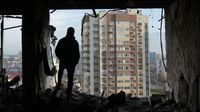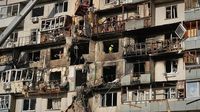In the early hours of November 14, 2025, the city of Kyiv was jolted awake by the deafening sounds of explosions, the night sky illuminated by the flash of missiles and the whir of hundreds of drones. According to Kyiv Independent journalists reporting from the ground, Russia unleashed one of its largest aerial assaults on the Ukrainian capital since the start of the full-scale invasion in February 2022. The attack, described by President Volodymyr Zelensky as “a wicked attack,” left at least seven people dead and dozens more injured, including two children and a pregnant woman.
Ukrainian officials reported that Russia fired approximately 430 drones and 18 missiles—including ballistic and aeroballistic types—at Kyiv and surrounding regions. The onslaught began around 12:45 a.m. local time, with repeated waves of explosions thundering across the city for hours. “The Russians are striking residential buildings,” warned Tymur Tkachenko, head of the Kyiv City Military Administration. “Many high-rise buildings across Kyiv have been affected, in almost every district.”
The devastation was widespread. At least eleven multi-story buildings were struck, with fires and evacuations reported in Podilskyi, Dniprovskyi, Desnianskyi, Solomianskyi, Sviatoshynskyi, and Obolonskyi districts. Emergency services worked frantically through the night, evacuating more than 40 residents from damaged buildings. Among the victims was 73-year-old Natalia Khodymchuk, widow of Valerii Khodymchuk—the first victim of the 1986 Chornobyl disaster—who died after a drone struck her apartment in the Troieshchyna district, according to Ukraine’s State Agency for Exclusion Zone Management.
“We fell asleep a little bit and then boom — there was smoke in the apartment, we began to suffocate,” Dmytro, a resident of the Desnianskyi District, told the Kyiv Independent. He, his wife, and their three-year-old son narrowly escaped death when a Shahed-type drone hit their building. “It was such a strong blast that everyone got up, took what we could, and left. A meter away from us, last night, literally a meter to the left, a meter up, and this would have been our apartment.”
President Zelensky confirmed that the Azerbaijan embassy was also damaged by fragments of an Iskander-M ballistic missile. The capital’s mayor, Vitaliy Klitschko, initially reported six fatalities but later revised the figure as rescue crews struggled to reach those trapped under the rubble. Power outages swept through several districts of Kyiv, as well as Donetsk and Odesa oblasts, disrupting daily life and adding to the sense of chaos. Ukraine’s Energy Ministry urged residents to use electricity sparingly, while Vitaly Zaichenko, head of Ukrenergo, the state grid operator, promised, “We are doing our best to repair the system. Without future attacks, we believe we will be able to recover all our energy consumption in three weeks.”
The toll of the attack extended beyond Kyiv. In Kyiv Oblast, six people were injured, including a seven-year-old boy who suffered facial injuries. Homes, warehouses, industrial sites, and vehicles were all hit, according to Governor Mykola Kalashnyk. Across Ukraine, at least thirteen locations were struck by drones and missiles, with debris from destroyed drones falling on four additional areas. The southern region of Kherson endured fresh attacks, leaving one person dead in the divided frontline city. In the Donetsk region, a man was injured in Kramatorsk, a city known for families awaiting the return of soldiers from the frontlines. The Nikopol district in Dnipropetrovsk region also mourned the loss of a 65-year-old man, while the regions of Sumy and Kharkiv were not spared the overnight barrages.
Ukraine’s Air Force reported that waves of drones targeted not just the capital but also the country’s central, southern, and eastern regions. Monitoring groups estimated that upwards of 120 drones and decoys were headed for Kyiv alone. Ukrainian defenses managed to shoot down or jam two Kh-47M2 “Kinzhal” air-launched ballistic missiles and 91 Shahed drones, according to the Armed Forces. Still, with 135 strike drones and three ballistic missiles launched overnight, the sheer scale of the assault left communities reeling.
The attacks also battered the city’s infrastructure. A hospital, a school, and wooden buildings at a sports facility were all damaged, the State Emergency Service reported. Fires broke out on the upper floors of a high-rise in Desnianskyi, and sections of the district heating network were left in disrepair. Emergency crews continued to assess the full extent of the damage as daylight broke over the battered city.
For Kyiv’s residents, these attacks are a grim continuation of life under siege. Eighty-one-year-old Valentina, who lives in Desnianskyi District, described the terror of the night: “My apartment shook like an earthquake. It’s scary each time, you shouldn’t get used to missiles. As long as Russia exists, there won’t be peace anywhere. They don’t let anyone live.”
But the suffering is not limited to immediate destruction. For the third consecutive winter, Ukrainians like Oleksandra Kovalenko and her family have been forced to adapt to life in the dark. “Everyone has more or less adapted,” Kovalenko told The New York Times, describing how her family relies on power banks, headlamps, and trips to shopping malls to recharge devices during blackouts. Yet what truly sustained them through previous winters was the steady flow of gas that kept stoves burning and radiators warm. Now, with Russia expanding its attacks to target Ukraine’s gas infrastructure—including wells, storage sites, and pipelines—Kovalenko and millions of others fear losing their last lifeline. “If we can somehow live without electricity, then living without gas — I’m afraid to even picture it,” she said. “I don’t want to.”
Gas remains the primary source of heat and cooking fuel for 80 percent of Ukrainian households, according to Sergii Koretskyi, CEO of Naftogaz. Most apartment blocks depend on centralized heating powered by gas, making the threat to this infrastructure a nightmare scenario as Ukraine heads into what officials warn could be its harshest winter since the war began.
While Ukrainian cities endured these attacks, the conflict’s reach extended beyond Ukraine’s borders. On November 14, a major oil terminal in the Russian port city of Novorossiysk, responsible for approximately 2% of global exports, temporarily suspended operations following Ukrainian attacks, according to Russian officials and Telegram channels. The incident underscores how the war’s impact is reverberating through international energy markets as well.
Despite the devastation, the spirit of Ukrainian civilians remains unbroken. As Dmytro, the Desnianskyi resident, expressed: “I’m simply speechless. You can’t fight against civilians like that. And even if you are fighting, have a conscience, fight against soldiers instead of civilians, grandmothers, old people, animals who are just sleeping in their beds.”
Russia’s campaign of missile and drone strikes has become a brutal hallmark of its invasion, with officials and analysts noting a recent intensification targeting not just residential areas but also the country’s vital energy infrastructure. The strategy appears aimed at breaking Ukrainian resilience and plunging the country into darkness and cold as winter sets in. In the words of President Zelensky, the latest assault was nothing less than “a wicked attack.”
As emergency crews continue to sift through the rubble and families brace for another winter of uncertainty, the resilience of Ukraine’s people is being tested as never before. Yet, even as the missiles fall and the nights grow colder, hope and defiance persist in the battered heart of Kyiv and beyond.


